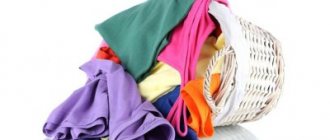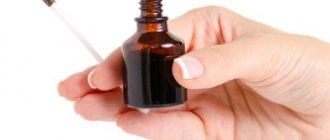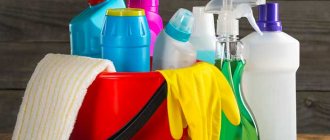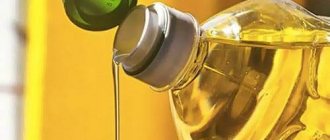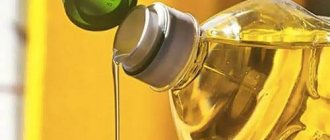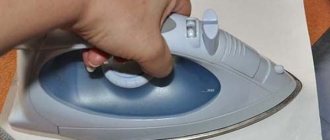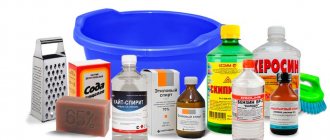How and with what you can wash, wash, remove, put away, erase, clean iodine.
Iodine is one of the most popular antiseptics. We use it regularly in the most emergency situations. However, despite the positive reviews on the medical side, it has a number of negative effects, the main one of which is corrosiveness to the surface.
Often, when opened, the lid of the bottle can contaminate linoleum, parquet, upholstery and even tiles, and not to mention your hands. However, today there are many methods that help to easily and quickly remove dirt from any surface. It is enough to arm yourself with a few tips that will help keep your apartment clean, as well as wash away solution stains from visible areas of the skin. Well, let's talk about which iodine stain remover is the most effective and figure out how to use it correctly.
How and with what to quickly wash off iodine from the skin of your hands, fingers, and face?
Very often, when iodine is applied to “sick areas”, the product also ends up on healthy skin. It is especially unpleasant if a similar situation occurs, and iodine stains reliably eat into the skin of the arms, legs, and décolleté.
Craftsmen use dozens of methods to combat iodine stains. However, not all of them are gentle; some have a very negative effect on the skin. That is why, when choosing the method by which you will cleanse the body of iodine, you must be guided primarily by the safety of the product.
The best means for removing iodine stains from skin and other surfaces are washing powder and bleach from Amway. With their help, you can remove all dirt without damaging the skin and decorative finishes in the house in just a few minutes.
Amway washing powder has long been known for its quality and ability to remove even the oldest and “difficult” stains. In order to get rid of traces of iodine on the skin you need to:
- Make a solution of water and powder. For 1 liter of water, it is enough to take 2 ml of booster powder.
- Apply the prepared solution to the stain and massage lightly. Remember that you are working with leather, not fabric, so there is no need for excessive force.
- The entire procedure should last approximately 5 minutes, however, if a satisfactory result becomes noticeable earlier, the procedure should be stopped.
- Rinse off the solution with running water.
- You must understand that it is possible that all the iodine will not be removed immediately. Therefore, if necessary, the procedure can be repeated.
- Don’t forget an important fact: any household chemicals can cause allergies in a person, so be extremely careful and careful, and even better, test the powder on a small area of skin before you start washing.
Wash off iodine from skin
Bleach from the same company is no less popular. This product is produced in granules, which must be dissolved in water for bleaching.
- So, dissolve a small amount of bleach in water. Let us immediately note that the water must be hot. Despite the manufacturer’s beliefs that the product can be dissolved even in cold water, people’s reviews still say the opposite.
- Apply the solution to the skin, following all safety rules.
- Wait a few minutes and rinse with water.
There are also several folk methods using which you can cleanse your skin of iodine. The most popular are:
- Using laundry soap 72% (after soaping your hands for an hour at intervals of 15 minutes, you can whiten your skin)
- Alcohol-containing products (you can use lotions, colognes, medical alcohol, vodka, but this method is aggressive, since the skin loses moisture under the influence of alcohol and can cause irritation). When using these methods, be careful and monitor how your skin reacts. In case of any redness or irritation, stop the procedure immediately.
- Lemon juice (by treating surfaces with natural bleaching agents, you can remove any type of contaminant, including iodine)
- Hydrogen peroxide (should be used in the same way as lemon juice)
- Baking soda (rub baking soda onto damp skin, then rinse and use a cream or lotion that will help avoid dehydration)
What to do if iodine gets on your hair
It happens that when treating wounds, iodine ends up on the hair. It is advisable to wash your hair with shampoo, do not allow the iodine to be absorbed and dry out. In the worst case, the hair structure will be damaged. Hair will become dry and brittle. Shampoo or conditioner will cleanse your hair.
Tips and tricks
There are many proven methods for cleansing the skin of iodine. If you follow the recommendations and follow safety rules, cleaning up the contamination will be easy. But some people are in such a hurry to whiten their skin and wash away dirt that they make mistakes that lead to negative consequences.
- Treat the skin with alcohol with extreme care, otherwise you may get a skin burn.
- Do not use products on problematic, damaged skin. Products can corrode it and lead to additional wounds and cracks.
- It should be remembered that many products can dry out the skin. It is better not to use these products if your skin is dry, flaky, or damaged.
- Some products may cause an allergic reaction. If the skin becomes red or itchy after contact with the product, you should immediately stop cleansing and rinse the problem area thoroughly with water.
- Skin burns often occur from contact with iodine solution. The skin becomes inflamed and blisters appear. It is important to prevent infection from entering the damaged area. Blisters can be treated with sea buckthorn oil and a tea compress applied. If prescribed by a doctor, you can use special medications in the form of ointments Levomekol, Bepanten. In case of burns and blisters, it is better to seek medical help at a hospital.
How and with what to wash off iodine from hair?
Hair is a porous organic material, so if iodine gets into the structural pores, it will be very difficult to remove the resulting red color. This happens because this antiseptic acts on the principle of a dye, and the alcohol content in the composition destroys moisture.
Rinse iodine from hair
The best solution if iodine gets into your hair is to get a new haircut or change your hair color to a darker one. However, if you are not ready for such decisive action, then you can use the following means:
- Laundry soap 72% (by washing your hair several times, a high concentration of detergent components will help remove a large number of coloring pigments)
- Coca-Cola (after rinsing the affected area with the drink, wait for 15-20 minutes, then rinse well with running water)
- Oil. You can use olive, coconut and even sunflower. By treating the affected area with a cotton pad, there will be significantly less coloring pigments in the hair.
- It is also worth trying a mask with henna (since this natural dye gives the hair a red tint, you can hide the iodine stain, making the color more natural)
How to remove iodine from the skin of your hands and body?
How to remove iodine without “magic” chemistry, which is always not at hand? Proven remedies for mothers and grandmothers exist for all occasions. The first aid kit, the household shelf at home, and the refrigerator contain effective, inexpensive ways to deal with nasty stains.
Vegetable oil
The simplest method. Vegetable oil (no matter whether refined or not) is poured onto a cotton pad, which is used to wipe off the drops. There is no need to rub until it turns red; if the stain does not come off right away, you should wash your hands with soap and repeat the procedure after an hour and a half.
Fat cream
The cream fades stains and nourishes hands. Useful stain remover. You need to spread the cream on your skin, wait 5-10 minutes, then wash your hands with soap.
Lemon or citric acid
Freshly squeezed lemon juice will fade the stain. The same thing happens thanks to citric acid (before use, it should be diluted with a few drops of water until a thick paste forms). Apply the juice to a cotton swab and apply it to the skin for 5-7 minutes (the acid is spread on the stain). After this, wash your hands (you can even do it without soap). Citric acid invigorates the skin, restores youth, so your hands will be happy with the unexpected “mask”.
We recommend reading: Now you can clean fresh and dried silicone sealant stains from any surface and fabric
Soap solution
Hand washing with soap will have a good effect on iodine stained skin - it will become clean. There is another option for cleansing your hands of stubborn dirt - wash your hair (for a long time, thoroughly, with shampoo, balm, conditioner).
Dishwashing liquid
Iodine can cause economic zeal. Dishwashing detergents do an excellent job of removing stains like these. To get rid of the problem, wash dishes without gloves, the more, the better. The kitchen shines, the hands are clean - ideal.
Medical alcohol
Application is standard: pour alcohol onto a cotton swab and wipe the skin. Use with caution, as alcohol dries out the skin greatly, and with prolonged contact it can leave dry burns, so it is better to immediately lubricate your hands with a nourishing cream.
Hydrogen peroxide or chlorhexidine
Hydrogen peroxide 3% (regular, from the first aid kit) will help quickly remove iodine from the skin. You need to moisten a cotton pad, apply it to the skin for 5-10 seconds, and wipe the place of the former stain and the area around it with the other side of the disc. Ready. Chlorhexidine works the same way. Even for children, its use is not dangerous.
Sea salt
How to remove large iodine stains? Take a bath with sea salt. It perfectly erases all traces and lifts your spirits. Only salt should be taken without coloring substances, with them there is a chance of residual yellowness.
Bee honey scrub
Freshly prepared salt and honey scrub is a universal remedy:
- Can erase iodine, potassium permanganate, brilliant green.
- Cleanses the skin by exfoliating the top layers.
- Serves as a nourishing mask.
- Opens skin pores, stimulates blood circulation.
- Helps fight cellulite.
Fine kitchen salt (3 tbsp.) is diluted with 1 tbsp. l. honey, the composition is applied to the iodine stain, around it, additionally on other skin, even on the whole body at once, lightly rubbed with fingers and washed off with warm water after 5-10 minutes. Cleansing and “spa effect” are guaranteed.
We recommend reading: How to remove iodine stains from textiles and more
Soda
Baking soda dries out the skin. When trying to remove iodine from the face or other delicate areas with baking soda, you may end up with a rough spot. But for hands it is an ideal product. You can take a soda bath (3 tablespoons of soda per liter of warm water) for 15 minutes. It will not only discolor the stain, but also partially whiten the nails. After the bath you need to rinse your hands. Another option: dilute the powder with a few drops of water to a thick paste and apply to the stain for 5–10 minutes, then rinse well with running water.
All of the above methods are safe, and also extremely useful. However, iodine can be removed using nail polish remover, acetone, and other similar compounds. Their use is more of an emergency measure and has a bad effect on the skin, respiratory system, and manicure.
How and with what to remove iodine from white and colored clothes, jeans?
To remove the remnants of this antiseptic from the fabric, it is necessary to use several stages of its cleansing. You can also use bleach or Amway powder, which do not require additional manipulation when washing. Among the available means, the following are widely used:
- White. Soaking white items for 30-40 minutes. in diluted bleach, you must first pour the product onto the stain. After the specified time has passed, you need to wash it as usual in cold water.
- Milk. Fill the fabric with liquid and leave for 20 minutes, then wash with laundry soap in cold water.
- Denatured alcohol. Treat the stain with iodine and wait until the dirt dissolves. Next, you need to wash your clothes in the traditional way.
- Toilet bowl cleaner. Pour the gel onto the fabric and wait 5-7 minutes, then wash. However, this method is only suitable for snow-white things, and during the process it is necessary to wear protective hand gloves
- Bleaches. After pouring the product onto the stain, wait 20 minutes. and remove residues using normal washing. But such products should only be used for white outfits.
Wash off iodine from clothes
To remove iodine stains from colored fabrics and jeans, you cannot use aggressive chemicals, as they can disrupt the structure of the fabric fibers and also change the color. The most gentle methods are:
- Washing using laundry soap (for automatic washing, can be used in liquid form)
- Potato starch. This method is only suitable for blue items. Pour starch onto the stain, moisten it and leave for 12 hours. After which the item should be washed using laundry soap.
If iodine stains were not destroyed in the early stages of formation, they will be much more difficult to remove. However, this does not mean that it is impossible to remove old stains. For a higher effect, the procedure must be repeated until the surface regains its original appearance. To remove stubborn stains from clothes, you will need:
- Treat the surface with acetone, and then proceed with traditional washing (pre-moisten a small area of the fabric in the solvent, since strong substances can disturb the color of the fibers). Pay attention to the color of things
- Treat colored fabric with a cotton pad soaked in denatured alcohol. After 15 min. wash with laundry soap
- For white items, you can use soda and vinegar, but this method will not work for thin natural fabrics. Sprinkle baking soda on the stain and pour in vinegar. After the reaction is complete, wash with laundry soap.
- Soak snow-white fabrics for 3-4 hours in a solution of white and water, then wash thoroughly
- Vanish-type bleach can also deal with old stains. Pour the product onto the contaminated area. After 10-15 minutes. rinse with cold water and rinse
- Don’t forget about the previously mentioned powder and bleach from Amway. These tools do an excellent job with such tasks. Soak the stain or the entire item in a solution of these products and leave for at least 30 minutes. If the stain is very old, it is better to leave it overnight. After this, wash the items again with regular powder and rinse them well.
How to get rid of iodine on different surfaces, skin and hair?
You need to remove iodine from various materials using old and proven means. The main thing is not to waste time and start cleaning quickly, since stubborn stains are much more difficult to remove.
From body skin and hair
Iodine evaporates from the skin on its own, gradually being washed off when washed. However, if there is an urgent need to remove a stain, for example, from the face, then you can use effective means. Iodine can be easily scrubbed off with hydrogen peroxide, soap (especially laundry soap), lemon juice, alcohol or alcohol-containing liquids. You can sprinkle baking soda on the stain and let it sit for about 10 minutes. After using peroxide or alcohol, you should immediately apply cream to your face, since the latter is very drying to the skin.
If iodine gets on your hair, it is quite difficult to remove it. Regular shampoos will not help here, since the substance itself acts like a chemical dye. However, you can try some remedies. First you need to wash your hair several times using laundry soap. It has an unpleasant smell, but it removes dyes well. Another way is to apply Coca-Cola or Pepsi to your hair, leave it for 20 minutes, and then rinse thoroughly with water.
With leather furniture
You can get rid of traces of iodine on a leather surface using products that can be found in every home. Regular alcohol or vodka, as well as alcohol-containing liquids, such as cologne or perfume, will help to significantly lighten or completely remove the stain.
The following products are also good for the skin:
- laundry soap solution;
- ammonia;
- special cleaners for leather furniture, for example Avel, Flat;
- hairspray, which is applied to the stain, rubbed lightly with a soft brush and left for two hours, then rinsed off.
Leather can become damaged if treated with turpentine, solvents, or household chemicals containing strong acids or chlorine. You can ruin leather upholstery if you rub it with a hard brush.
From clothes
It is difficult to remove iodine from fabrics, but you can try several remedies if you really want to restore a damaged item. From white clothes, for example, a T-shirt, bleach will help remove it; Whiteness will do. It is recommended to first pour the product onto the stain and rub it with a brush, then soak it in it for about half an hour, and after that wash it as usual.
Another way is to use Domestos to clean the toilet; it contains bleaching components, so again it is only suitable for light-colored fabrics. It must be applied to the stain and left for 5-7 minutes, then wash the item with regular powder.
To remove iodine from colored items, you can use ammonia, acetone or potato starch.
- Ammonia is mixed with water (15–20 drops are needed per glass). Then pour it into a basin with soiled clothes and add another liter of medium-temperature water. Leave for half an hour, then rinse and wash.
- Another option is to soak the clothes for 10 minutes in warm water, then sprinkle generously with starch and rub well. Leave it like this for 15 minutes and then wash it with powder.
- You can use acetone to remove stains from items that cannot be washed. It is applied to a cotton swab and wiped over the contaminated area.
From furniture
If iodine gets on a wooden surface, after a while it will evaporate on its own. Elements made of plastic, chipboard, varnished wood and other materials can be washed using the following products:
- Potato. Rub the contaminated area well with a slice of peeled root vegetable; if necessary, you can leave it on the stain for 10 minutes, it will absorb iodine.
- Baking soda. It is necessary to add a little water to the powder so that the consistency of the mixture resembles a paste, and then apply it to the stain and leave until it dries; if necessary, you can repeat the cleaning procedure until the stain is completely removed.
- Ascorbic acid. Two tablets are poured into 100 ml of warm water, then the contaminated area is treated with this solution.
If iodine gets on textile upholstery or leatherette, the following remedies will help deal with it:
- Household chemical stain removers: Dr Beckmann, Vanish.
- Hydrogen peroxide.
- Baking soda and acetic acid. Powder is poured onto the stain and poured with a small amount of the second component, then covered with a rag and left for 10–12 hours, then washed with warm water.
From the floor
Iodine evaporates over time from parquet, laminate, ceramic or ceramic tiles and linoleum. If the stain needs to be removed urgently, you can use the following means:
- Mix equal parts baking soda and table salt. The mixture is applied to the stain, covered with a rag and left in this form overnight, after which the floor is washed with plain water.
- Bleach Whiteness. 2–3 tbsp. l. Add the product to a liter of warm water, wet the cloth and thoroughly treat the contaminated area; you can leave the cloth on the stain for 10–15 minutes, then wash off the residue.
- Alcohol or cologne. If you are processing linoleum, the liquid should be colorless. You need to drop a small amount of the product onto a cotton swab and rub the stain until it turns pale, repeat if necessary.
- 9% vinegar. Just apply it to a cloth and wipe the surface. The fact is that iodine reacts with acetic acid and crystallizes, after which it can be easily removed with a damp cloth.
From carpet or carpeting
Acetone, baking soda with vinegar, and potatoes will help remove iodine stains from carpet. Methods of application are described above.
How and what to use to remove iodine from furniture fabric?
To remove stains from the surface of furniture, it is enough to wash the upholstery covers using standard methods. However, if this is not possible, it is necessary to use treatment of the affected area. Iodine can be easily broken down from upholstery fabrics using the following methods:
- When using baking soda. Treat the stain with baking soda and leave for 12 hours. Then remove the residue with a damp cloth.
- Using a stain remover containing chlorine. Apply a sufficient amount of product to the stain and wait 10 minutes. Next you need to treat the fabric using a brush
- Treat the surface with raw potatoes. You need to rub half a potato onto the stain, and after it dries, you should wipe it with water.
Remove iodine from furniture
To remove iodine from white furniture surfaces, use the following means:
- Aspirin (dissolve 1 tablet in 100 ml warm water)
- Boric acid
- Ethanol
- Sodium thiosulfate (after use, wash the stain with soapy water)
- Ammonia (1 tsp for 2 glasses of water)
- Formic acid
How and with what to remove iodine from a leather sofa?
Yodine on a leather sofa, it would seem that the situation is a dead end and there is only one way out - buying new room furniture, but not everything is so bad. Let's see what can be done in such a situation.
Many standard methods should not be used to remove iodine stains as they may damage the upholstery. The use of the following cleaning products is strictly not recommended:
- Turpentine
- Furniture varnish
- Bleach
- Lamps
- Household chemicals with acids
- Solvent
- Hard brushes
- Chlorine-containing products
- Drying oil
Wash off iodine from a leather sofa
You can remove iodine stains in the following ways:
- Treating the coating with soapy water
- Ammonia
- Special leather care products
- Rubbing the surface with vodka
- Treat the area with hairspray. To do this, apply varnish to the stain, lightly rub the area with a brush and leave for 1-2 hours.
If it is not possible to completely remove iodine, you can use varnish or paint that colors leather products without damaging the surface. However, in such a situation, it is best to consult with specialists.
How to remove iodine from nails?
Iodine nail masks are a good strengthening agent, only with consequences in the form of yellowness. You have to think about how to remove iodine from cuticles, nails, and finger skin after the strengthening session.
Lemon juice. You can carefully apply the juice to a cotton pad and wipe off the yellowness. Or cut a lemon in half, crush the middle and stick all your fingers in there. One half is enough to clean both hands; the nails additionally receive a nourishing mask and whitening peeling for the inside of the nail plate. After the procedure, the remaining juice is removed with running water, hands are lubricated with olive oil or rich cream. This method is absolutely not suitable if there are burrs, cuts, or wounds.
We recommend reading: All methods of purifying gold
Iodine is not as scary as it seems at first glance. The above are useful and pleasant ways to get rid of such stains. You can try everything and get real pleasure from solving the problem.
How and with what to remove iodine from wooden surfaces, furniture, parquet?
The main task when cleaning such surfaces is the correct choice of means and methods.
Since the rocks have a porous structure, the color remains for a long time. And aggressive household chemicals not only change the shade of parquet, but also make it thinner. The following methods for removing characteristic stains have proven effective:
- Dishwashing detergent (the surface should be treated with a soft sponge)
- White. Prepare the solution: 2-3 tbsp. spoons per 1 liter. water; It is forbidden to use bleach in its pure form, as it will lighten not only the stain, but also the varnish, including the coloring pigment. The solution is applied to a sponge and left on the stain until it noticeably decreases.
- Vinegar 9% (after use, you need to wash the floors)
- Vodka (after treating the surface, rub the stain with an eraser)
Remove iodine from wooden surfaces
- Ammonia (for the solution you need: a glass of warm water and 1 tsp of product)
- Baking soda. First, you need to thoroughly wash the floors with water and apply baking soda. After this, you need to cover the surface with a sponge and wait 10-12 hours.
- In professional household supply stores you can also find gels and solutions designed to clean wooden surfaces from iodine stains. However, before using them, it is important to carefully read the instructions, since a high concentration of active substances can damage the surface.
How and with what to remove iodine from linoleum?
In order to clean linoleum from iodine stains, you should use a few simple tips:
- Having previously cleaned the surface with warm water, we proceed to apply a mixture of salt and baking soda to the stain. Apply the product, cover with a sponge or cotton cloth, let dry for 10-12 hours, then remove the residue and wash the linoleum
- If iodine has been absorbed into the surface, using soda and pumice will do. Apply the product to the linoleum and process until the stain completely disappears
Remove iodine from linoleum
- To speed up the cleaning process, the stain needs an increased amount of light, so do not close the curtains during the first few days. After 3-5 weeks, the stain may disappear without intervention
- It is acceptable to use radical cleaning products, which can be purchased in specialized stores specializing in professional cleaning.
- It is also worth trying potato starch, which is applied to the stain and covered with a sponge, and then washed off with water.
- You can leave a thick slice of raw potato overnight, which will help remove iodine contamination
Removing iodine from linoleum
If iodine gets on linoleum, you must act quickly before the substance eats into the coating.
It is not advisable to use an antiseptic near difficult-to-clean surfaces. It is better to work with the substance over the sink. If iodine has already reached the linoleum, the algorithm of actions is as follows:
- Use a cloth to remove any liquid that has not yet been absorbed.
- Then wash the floor with a cloth soaked in alcohol. If it is unavailable, you can use alcohol or gasoline.
- Remove remaining iodine using a stiff brush and soap or dishwashing detergent.
You can remove iodine from a linoleum-covered floor using the following method:
- Moisten the blot with hot water.
- Dissolve soda in water in a 1:1 ratio.
- Dip a rag into the resulting liquid.
- Place it on the linoleum.
- Remove residues after 10-12 hours.
The method is harmless, but only works if the iodine stain is fresh.
Ascorbic acid will help save linoleum:
- Dilute 2 tablets of ascorbic acid in 600 ml of water.
- Place a rag soaked in this solution on the linoleum for 10-12 hours.
- Remove remaining liquid.
How and with what to wash iodine from plastic, tables, countertops?
Iodine on tables is a very common situation. Do not immediately give in to panic, because this problem is completely solvable.
In order to clean different surfaces from iodine, you cannot use the same cleaning method, since the effect of the active components on different materials manifests itself differently. To clean plastic, you need to adopt the following methods:
- Clean with a sponge and water. Next, apply vodka or alcohol (you can use cologne or lotion), then use three stationery erasers to
- We wash the surface with water and treat it with a cotton pad soaked in vodka or alcohol.
Wash iodine from plastic
To clean tables and countertops, the following methods can be used:
- Dissolve a couple of ascorbic acid tablets in 100 ml of warm water, then treat the surface using a cotton pad soaked in the solution.
- Baking soda has also proven effective. Stir it to the consistency of porridge and leave it on the surface until completely dry. It is recommended to carry out the procedure 2 times to remove all iodine residues
- With aspirin you can cure not only headaches, but also furniture. Dilute 1 tablet in 100 ml of water and treat the wood
It is important to remember that pre-cleaning with warm water will help open the pores of the wood, which means that the use of further products will be much more effective. After cleaning is completed, the furniture must be washed with soapy water or warm water to remove all harmful particles.
As you can see, there are a huge number of means and methods for combating iodine stains. Despite this, I would like to draw your attention to an important fact: you should not delay the moment of washing if an unforeseen situation arises. Iodine can be easily removed using improvised means only in the first day after contamination, but by delaying the moment of washing, you reduce your chances of “revitalizing” the item. If for some reason you were unable to undertake a set of resuscitation methods for your clothes, you should use the services of a dry cleaner, which uses professional detergents and removes any stains.
